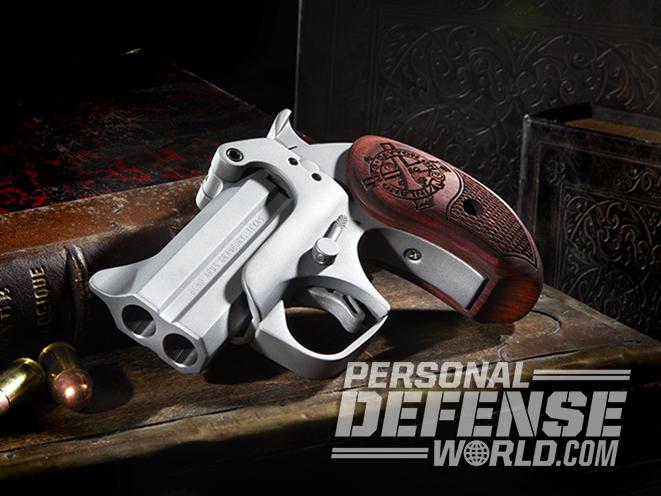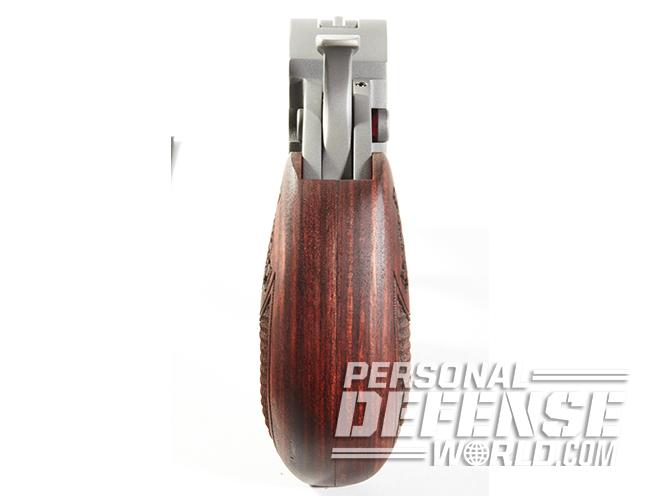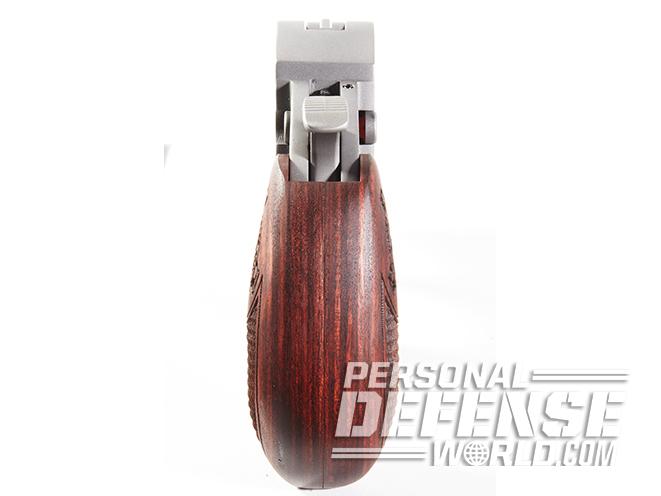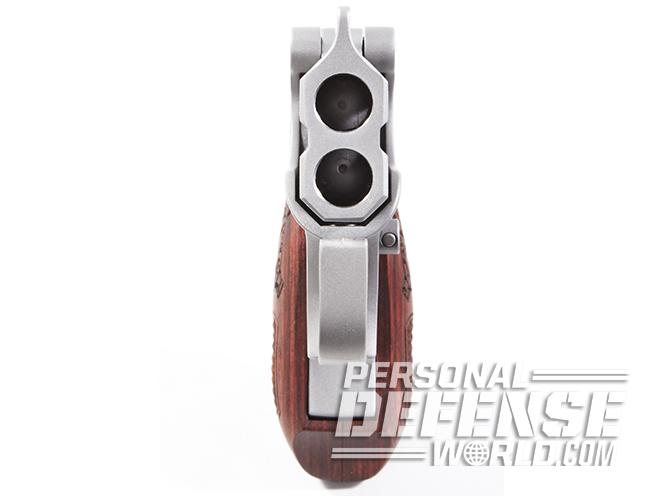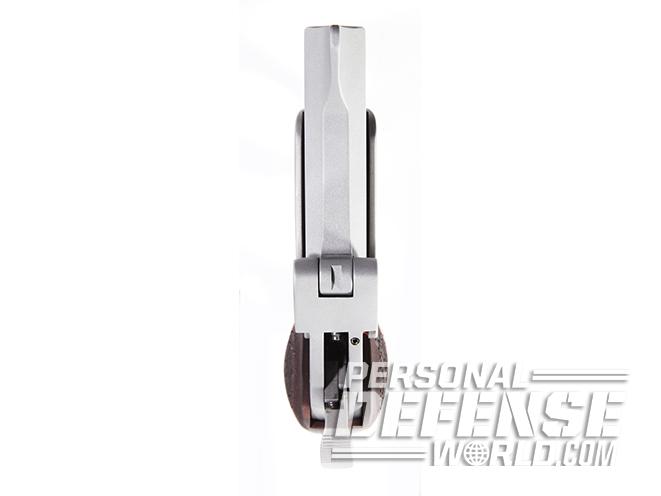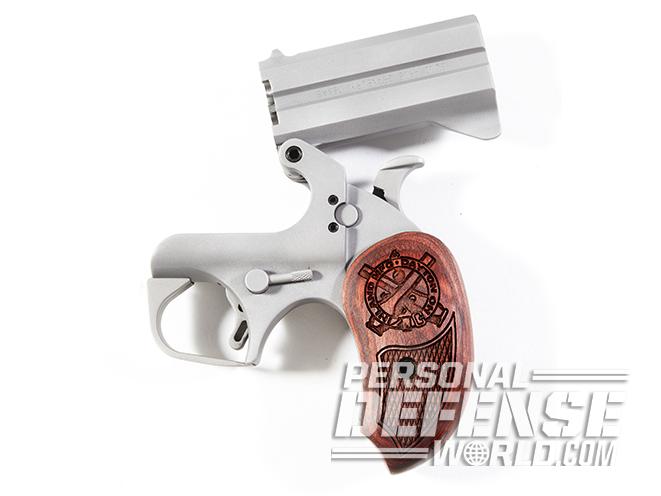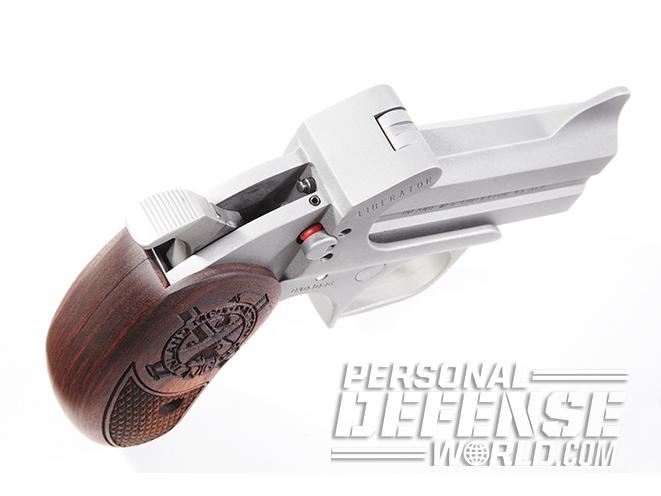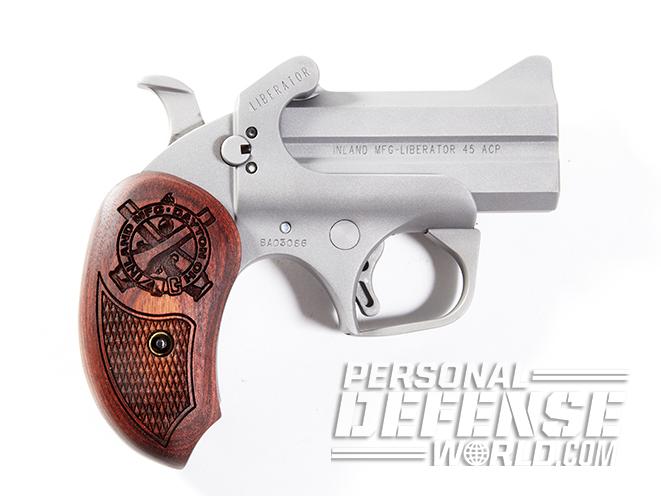All-out war calls for answers to problems that may have never come up before. In World War II, the Allies were looking for a way to help resistance fighters in Nazi-occupied areas obtain weapons and ammunition. The easiest way for a member of the French Resistance, for example, to obtain a firearm was to take it from a dead or captured enemy soldier. And it was helpful if the resistance member had some kind of weapon to obtain said firearm.
Enter the FP-45 Liberator. This was a small, single-shot pistol in .45 ACP designed at the Inland Division of General Motors in Dayton, Ohio, in 1942. For counter-intelligence purposes, it was classified as a flare pistol, hence the FP designation. It had a 4-inch, smoothbore barrel, and the gun itself was only 5.55 inches long and weighed about 16 ounces. Made basically of stamped-steel parts, it was easy to mass produce, and some 3 million were made in about 11 weeks. It had an effective range of 1 to 4 yards and was shipped in a cardboard box along with 10 cartridges and a comic-book-style instruction sheet. While there are few records of this gun being issued and used, it did see action in both the European and Pacific Theaters.
Inland Liberator: A Modern Take

Fast-forward to today. Inland Manufacturing—in cooperation with Bond Arms—is now offering a new Liberator pistol in the spirit of the FP-45. This particular version of the Liberator is also in .45 ACP, but its base platform is the over/under derringer produced by Bond Arms. The head honchos of Inland and Bond Arms—Ron Norton and Gordon Bond, respectively—have been friends for years, and Bond has always considered Norton an “innovator” and offered some suggestions to make the “reborn” Liberator a reality.
Advertisement — Continue Reading Below
- RELATED STORY: Bond Arms Derringers – 5 Little Bond Beasts
First and foremost was the chambering, then Bond, in keeping with the original, added a “distressed look” with a dull phosphate-style finish on the metal and less gloss on the oversized rosewood stocks. This gives the Inland Liberator a military appearance without trying to replicate the original FP-45. According to Ron Norton, “I like to think that the Inland Liberator is a blend of the past and the future, a forging of yesterday’s simplicity created with modern firearms technology.”
This is a single-action gun with a rebounding hammer and a sliding bolt safety. There is also a safety locking device activated with a hex wrench that makes the gun child-proof. A rotating, spring-loaded hammer face moves via a selector cam when the hammer is cocked to hit the retracting upper and lower firing pins. The Inland Liberator has a removable triggerguard, and the spur trigger’s pull weight is between 6 and 7 pounds. Note: The trigger pivots and an extension acts directly on the sear to release the hammer, so you need to press the trigger on the lower portion or tip—otherwise the pull is more like 20 pounds.

On the left side of the frame is a simple spring-loaded locking lever that, when pivoted downward, unlocks the barrels so they can be tipped up for loading. A cutout on the left side of the barrel breech allows you to pull out the cases after firing. The port in the barrels also acts as a loaded-chamber indicator. Another item I discovered is that you can pivot the barrels open even when the gun is cocked.
Advertisement — Continue Reading Below
The 3-inch barrels are part of a one-piece assembly made of stainless steel. The fixed ramp front sight and square-notch rear sight are integral to the barrel assembly; the rear sight is part of the hinge. Unlike the original FP-45, the new Liberator’s barrels are rifled for enhanced accuracy.
The gun comes in a hinged and lockable black plastic case with a small hex-head wrench for the safety lock, an owner’s manual and literature from Bond Arms and Inland. The fit and finish on my test Liberator were very good overall, and the finish on the metal was evenly applied but somewhat susceptible to light scratching. The rosewood grips are oversized and cover the backstrap of the grip frame. The wood-to-wood fit was above average, but the wood-to-metal fitting was a little off at the top of the backstrap, up near the hammer. On the sides of the grip panels is some well-executed checkering and above this is the Inland Manufacturing logo.
Doubling Down
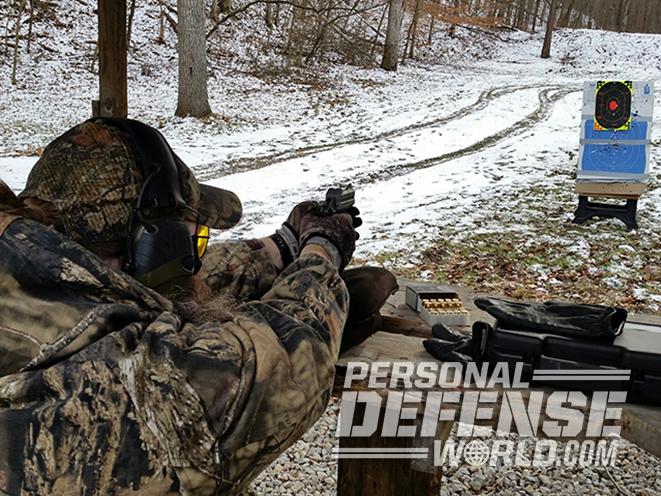
Advertisement — Continue Reading Below
As the Inland Liberator is primarily aimed at the self-defense market, I wanted a mix of traditional military-type and commercial defense ammunition. The original military load for the .45 ACP was a 230-grain FMJ. To duplicate this I selected Winchester’s 230-grain “White Box” FMJs. Next, I wanted some lighter-weight bullets, so I went with CorBon’s 165-grain +P JHPs and Federal’s 185-grain Personal Defense JHPs. I opted not to use any type of holster in keeping with the original intent of the FP-45 Liberator.
I ran all of the test ammo through my chronograph to see the velocities produced with the Liberator’s 3-inch barrels, and there weren’t any surprises here velocity-wise.
Since this is an over/under derringer, the supposition was that the stacked barrels wouldn’t shoot to the same point of aim (POA). I put up a rather large target at 7 yards for this reason. It also became apparent that the group sizes would have to be separated into top- and bottom-barrel groups. Three 2-shot groups were fired at each target, with the top- and bottom-barrel bullet holes being segregated.
Advertisement — Continue Reading Below
The owner’s manual said the Inland Liberator could be ammo sensitive. We had two test guns; one did not to like the Winchester FMJs and produced a number of light primer strikes with the lower barrel, so we withdrew it from testing. The second gun had no problem with any of the .45 ACP test ammunition, so we went with it.
My son, Jordan, was helping me, and he’d fire a series of groups, then I would. The best group of the day came with the CorBon +P JHPs. The three-hole cluster from the bottom barrel measured 1.53 inches but was some 5 inches below the POA. The best top-barrel three-shot group came in at 1.62 inches, and it was only 2.25 inches below the POA.
- RELATED STORY: Inland’s Advisor M1 Pistol Is a Solid Piece of WWII History
The hot CorBon +P ammo also had the most centered groups of the three test cartridges. Wanting to keep the groups separated, we found out the best way to tell which firing pin the hammer would hit was to cock the hammer, then carefully observe the hammer “head.” If there was a lot of space above it, the bottom barrel would fire—not so much and the top barrel would fire. It was decided that for this particular gun the top barrel had an edge on accuracy.
Advertisement — Continue Reading Below
Mission-wise, there’s not much difference between the Liberator of 1942 and the Liberator of today. This pistol is a close-range proposition, although the effective range of the Inland Liberator is a bit longer than the original’s due to the rifling in the barrels and the much-improved sights.
Jordan and I decided to do a practical shooting exercised based on what a real WWII resistance fighter might experience. I placed a B-27-type silhouette target at the 7-yard line and had Jordan slowly eased towards it as if it were an enemy sentry. With the Liberator in his right hand and concealed behind his leg, out of sight, he’d close with the “sentry,” bringing the gun up, cocking it while doing so and fire one shot into the center-mass and a second shot to the head from about 3 yards.
Without a glove, this wasn’t so much of a problem. A total of 12 shots were fired; one headshot was a near miss and one hit was in the center of the neck. The center-mass shots scored 3 in the X-ring, 1 in the 10-ring and 2 out in the 9-point scoring area. The shooting was done as quickly as possible with a one-handed hold. Once the trigger was mastered, the Liberator was fairly quick to get into action. The .45 ACP slugs would have done their job, and we would have gotten the sentry’s weapon and ammunition.
Advertisement — Continue Reading Below
Ready & Able
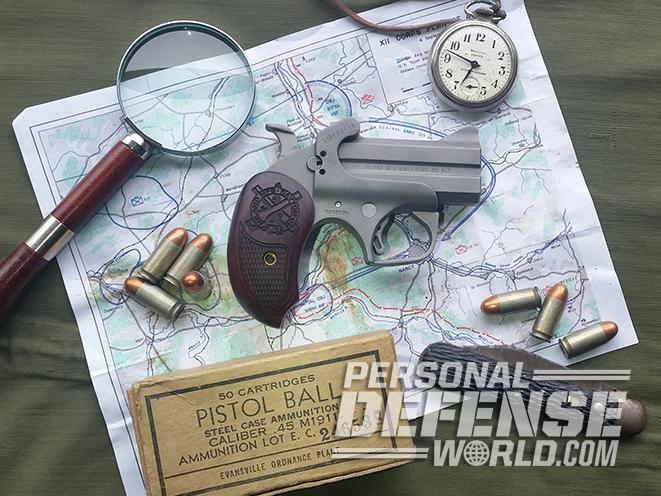
This little exercise pointed out that the best place to have this gun once a possible threat has been identified is in hand but out of sight. The hammer spur is wide and serrated for a good thumb purchase, but that spur is also a hook for snagging on the pocket liner or inside of a loose-fitting shirt or jacket. If I were carrying this gun, it would be in a pocket holster, and if I were expecting trouble, my thumb would be over the hammer, both to ease drawing the gun and to have it pre-positioned to cock the hammer after the pocket is cleared and the gun is being brought to bear. Although the original Liberator had a triggerguard, I would remove the triggerguard on this version, especially if I used a two-handed hold.
Caliber: .45 ACP
Advertisement — Continue Reading Below
Barrel: 3 inches
OA Length: 5 inches
Weight: 20 ounces (empty)
Advertisement — Continue Reading Below
Grips: Rosewood
Sights: Fixed
Action: SA
Finish: Matte stainless
Capacity: 2
MSRP: $495
